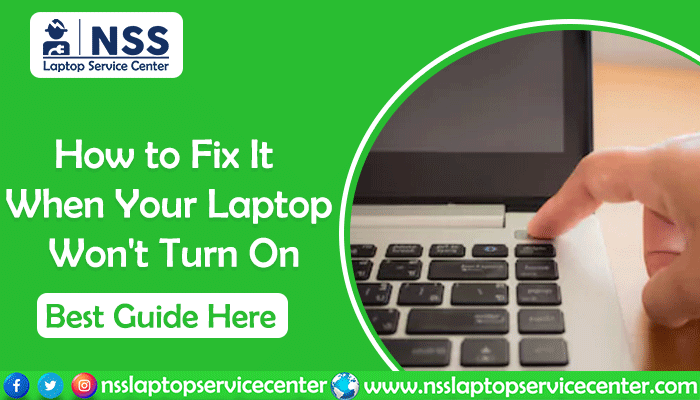
Hello Friends, I hope you are all fine!
It can be a traumatic experience when your laptop doesn't turn on, particularly when you rely on it as your primary device.
Taking a deep breath to know the potential causes would be best. If your laptop is not starting, you can fix this problem by following one of the six steps below, in which we've included information on how to get your laptop working and running again, hopefully.
Step 1: Check the power supply
You have encountered one of the most common problems. Various things can go wrong, such as using a faulty laptop power supply that delivers the incorrect voltage to a blown fuse in the plug. So check whether the adapter you are using for your laptop is the correct one that gives the correct voltage and amps. You can confirm this by stickers or markings on both the power supply and laptop sides. It would be best if you had some third-party chargers for your output power at a speed that is only equivalent to what your device requires to run. Notably, older machines can lose significant amounts of battery when in sleep mode and may, therefore, need not turn on if one of these chargers is used.
Read Also: How to Take Care of Your Laptop in Summer
Many laptops from the same manufacturer use the same size plug; if you own more than one, it's not too difficult to plug in the wrong power supply, which might provide a different voltage or insufficient current.
Check the fuse in the plug to see if it's the correct charger. To remove the fuse, use a screwdriver and swap it for one that's known to be good. Your spare power cable will plug into your power supply, which is a much quicker way to test that it isn't the fuse of the fault.
Check the wire itself since power supplies get beaten up, especially if you carry them everywhere. There are weak points at the ends where they join the black brick and the plug connecting to the laptop. If you see the colored wires inside the black outer protection, buying a new power supply unit (PSU) could be time.
If you face problems with a touchpad, it's worth checking out our guide to fix a cursor that's not moving.
Step 2: Check the screen
Disconnect external displays, including projectors and monitors, and ensure they're not stopping your laptop from booting into Windows.
Your computer's power LED lights are up, and you can hear the noise of hard disk or fans whirring, and there's no image on the screen. Then, make the room dark and check for a faint image on the net.
You may think it easy that your laptop isn't booting, but in fact, it's your screen that's the problem.
A faint image appears on the Windows logon screen, and the inverter could have failed. However, this applies only to old laptops before LED backlights came along.
Read Also: How Do I Fix Disk 100 in Windows 10 Task Manager
You must buy the correct replacement part since replacing an inverter is difficult. You can't afford to get it wrong, as inverters aren't exactly cheap. Professionals can handle this job well since your laptop is likely to be old, and it's probably time for you to buy a new one.
Your laptop is booting fine, but if there's no image, there must be a fault with your LCD panel. Therefore, replacing a laptop screen is possible but difficult since the screens can be costly.
Step 3: Unplug and removable USB drives or memory cards
Assuming that everything is okay with the screen and power supply, your computer may get stuck before it loads the Windows. The classic culprit here is the memory card or USB drive, which is left inserted into the card reader or USB port. You'll then typically see an error message such as "Operating system not found, " leading to unnecessary panic.
The BIOS is usually set to try booting from removable storage drives, including the cards, before the internal hard drive.
Also, check for the disc left in the DVD or Blu-ray drive.
Read Also: How To Troubleshoot and Fix Blue Screen?
Step 4: Try a rescue disc
If none of the above works, you can try booting from a USB drive or rescue disk.
If you have, then use the Windows DVD, or otherwise, you can download it using another computer from a rescue disc image that either burns it to a CD or DVD or extracts it from a USB flash drive. Then, attempt to fix the problem with Windows by booting from this.
If the cause of your problem is a virus, then rescue the disc from an anti-virus provider, as this will include scanning tools that can find and remove the malware.
Step 5: Boot into Safe Mode
You might be able to get into safe mode even if you can't boot into Windows. You'll get a menu offering to boot into Safe Mode by pressing F8 as your laptop starts. Then, you can enter into safe mode. If this won't work in Windows 10, you must be in Windows before entering the safe mode. Then, in that case, you'll need to boot from a drive or rescue disc as described above.
If you can enter safe mode, you can undo any changes that caused your laptop to stop booting. You could then try uninstalling any new programs you have recently installed by uninstalling a recently updated driver and creating a new user account if your account is corrupt.
Read Also: Best Way to Troubleshooting Keyboard Backlight Failure
Step 6: Check for faulty or incompatible hardware
If a newly installed memory or another piece of hardware might be preventing your computer from booting, remove it by reinstalling the old memory if necessary and then try again.
Your motherboard has LED readouts that show POST codes, then search it in the manual or online to find out what the code shown means.
It can often be tricky to get a newly built laptop to boot. The best tip we can give you is to disconnect everything except the bare minimum needed to boot to the BIOS:
· Motherboard
· CPU with heatsink attached
· Graphics card: if there's a graphics output on the motherboard, then remove any plug-in graphics cards
· One stick of memory. We recommend you remove and leave the single stick in slot 0 or whichever is mentioned in the manual.
· Power supply
· Monitor
All other hardware is unnecessary since you don't need a hard drive, optical drive, or other components to start your laptop.
Conclusion
We hope this blog will be helpful for laptop users who face problems while starting their laptops and how to fix them. The List of Authorised Laptop Service Centers in India:-
Dell Authorised Laptop Service Center in Delhi
Lenovo Authorised Laptop Service Center in Mumbai
HP Authorised Laptop Service Center in Kolkata
Asus Authorised Laptop Service Center in Vadodara
Frequently Asked Questions
Popular Services
- MacBook Battery Replacement Cost
- HP Printer Repair in Delhi NCR
- Dell Laptop Repair
- HP Laptop Repair
- Samsung Laptop Repair
- Lenovo Laptop Repair
- MacBook Repair
- Acer Laptop Repair
- Sony Vaio Laptop Repair
- Microsoft Surface Repair
- Asus Laptop Repair
- MSI Laptop Repair
- Fujitsu Laptop Repair
- Toshiba Laptop Repair
- HP Printer Repair Pune
- Microsoft Surface Battery Replacement
- Microsoft Surface Screen Replacement




